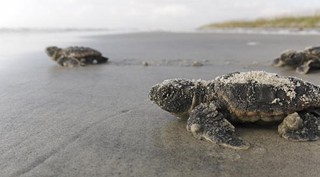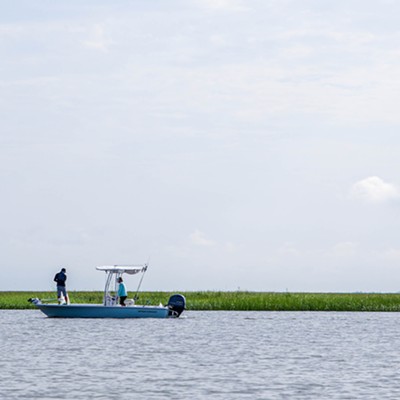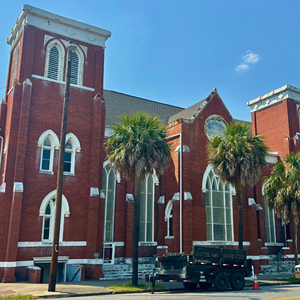She breaks surf silently, like a piece of driftwood lodged in the wet sand. Guided only by instinct, and by the position of the moon and stars, the turtle drags herself forward using her muscular front flippers.
Gravity is an entirely new concept for her. She weighs as much as 400 pounds, and she’s spent her adult life in the open ocean. Until now, there’s never been a reason to come ashore.
It’s nesting season.
To watch a sea turtle on the beach, in the dead of night, is like pulling back the veil on some secret ritual. You’re acutely aware that it’s something you’re not really supposed to see. The great reptile, so agile in the water, is hulking and heavy on land, and when she sees you, the only reason she doesn’t flee immediately back to the shadow and safety of the ocean is because she can’t do anything quickly now.
This reproductive rite takes place over and over again on Georgia beaches, nightly, from May to August. Sea turtles have been making these nocturnal landings since long before humans claimed everything for their own.
Before waterfront property, lighthouses, shrimpboats and seawalls. Before the barrier islands had even gelled off the coastline.
The most commonly–found species of sea turtle in the southeastern United States is the loggerhead — so named because it has an enormous head, particularly in comparison to the green turtle, which also nests every summer from Texas to the Carolinas.
Several times during the nesting months, mating takes place five miles or so off the coast. Studies indicate that the females actually lay their eggs on the very stretch of sand where they themselves were hatched, as much as 50 or more years before.
Somehow she knows to crawl past the high–tide line, usually at the base of a sand dune (provided there is one). She digs a “body pit” by flailing those front flippers back and forth, as if she were making a turtle–shaped snow angel.
Slowly, methodically, she uses her flat rear flippers to excavate an hourglass–shaped hole in the sand.
(Again, this is all through instinct. The turtle’s body is not even remotely flexible; she digs the nest without ever seeing it, or her eggs.).
Over the course of half an hour or so, about 100 leathery white eggs, the size of ping–pong balls, will be deposited into the hole (they’re quite wet, and goopy, and are in no danger of breaking at this stage).
Once she discerns there are no more eggs inside of her, the turtle — again, blindly using those rear flippers — scoops sand back into the hole.
Then the big swin–fins in the front go into action. She flings sand back and forth over the area, disguising the nest, and caps the effort with a few heave–ho body twists to further camouflage the area.
Laboriously, she turns around and begins the long crawl — a bit faster this time — back to the ocean. It’s about an hour after she first made landfall.
The only evidence that the turtle was here are the telltale tractor–trailer tracks left as she dragged herself from, and back to, the water.
Between 50 and 60 days later, the 3–inch baby turtles emerge from the nest, wiggle their way down to the sea, and begin their own perilous journey. Perhaps one in 100 will survive the harsh realities of life at sea to reach adulthood.
Tybee’s turtles
Of Georgia’s barrier islands, Tybee records the fewest number of loggerhead nests. There were only three in 2009; the record was 2007, with 11 nests.
(Compare this to the beaches of Brevard County, Florida, where several dozen turtles come ashore every single night, all summer long.)
"In all of Georgia, a big year would be 1,500 turtles for the whole coast,” says Terry Norton, the founder and chief veterinarian at the Georgia Sea Turtle Center on Jekyll Island.
Jekyll accounts for 10 percent of that number; mostly–wild Cumberland Island has the state’s busiest turtle beach.
“With Tybee, part of the issue is due to development and changes to the beaches, and the number of people on the beaches,” says Norton. “I’m sure that way back when, the numbers were much higher.”
Beach “renourishment” (dredging) and the density of humans and their well–lit dwellings has apparently made Tybee undesirable for the reptiles.
According to the Georgia Department of Natural Resources, sea turtle data has only been collected on the five miles of Tybee beachfront for 20 years.
Mark Dodd, the DNR wildlife biologist who coordinates Georgia’s sea turtle research and rescue programs, applauds Tybee’s recent efforts to raise public awareness of the presence of turtles on the beach.
“One of the reasons we focus on these animals,” Dodd says, “is that they’re an excellent indicator species, of the health of our ocean and beach ecosystems. So all the things we do to help recover loggerheads, they don’t just recover loggerheads, they help beach–nesting birds and a lot of marine organisms that rely on the same ecosystems.
“As an indicator species, loggerheads are telling us that as humans, we’re having a very profound impact on our ocean ecosystem,” he says.
“All their efforts on Tybee to control lights, to maintain the nesting habitat, everything they do to make that beach suitable for turtles, ultimately makes it better for humans. I think it’s a noble and worthwhile goal.”
Keep your distance
So what should you do if you encounter a sea turtle on the beach?
Leave it alone.
The loggerhead is listened as a Threatened Species, under the national Endangered Species Act of 1973, and if you’re “molesting” a turtle (meaning you’ve harmed, interfered with or touched it in any way) you’re committing a crime.
Nevertheless, it is possible to observe the turtle’s ancient ritual, if you’re careful.
If you’re patient.
If you can see in the dark.
Don’t use flashlights. Sea turtles are extremely sensitive to bright light; the most populous nesting beaches are those that keep the lights from human dwellings to a bare minimum. As she rests at surf’s edge, deciding if it’s safe to come ashore, the female is at her most wary. Any bright light, flicking on suddenly, will spook her, and she’ll turn around and swim away. A cigarette lighter will do it.
If she’s already making the long haul up the sand, any light, sound or obvious movement will seem like a threat, and she might still turn tail, even after 50 yards of laborious crawling. This is called a “false crawl,” and you (the observer) will feel pretty bad if you’ve caused it.
Stay away from the nest. If you come upon the telltale tracks, follow them (with your eyes) toward the dunes, and you might catch sight of the turtle in her “body pit,” laying her eggs. She’ll be there for a while. Some scientists say she goes into a sort of trance while the eggs are dropping, and that it’s safe to approach and watch from a few feet away.
It’s better to keep at a good distance, though; she might still abandon the whole thing if she senses your presence.
After she’s finished laying, you’ll see the sand flailing as she attempts to camouflage the nest site. Once she’s turned herself around and begins crawling back towards the water, that’s when it’s safe to approach her and get a close–up look.
Just make sure she’s well away from the nest and heading oceanward before you do.
The hatchlings. You’ll never see them. They leave the nest and hit the beach so quickly, it’s a rarely observed natural phenomenon. If you do happen upon them, again, don’t interfere in any way.
For more information about loggerhead nesting in coastal Georgia see www.carettaresearchproject.org, and www.tybeemarinescience.org.































